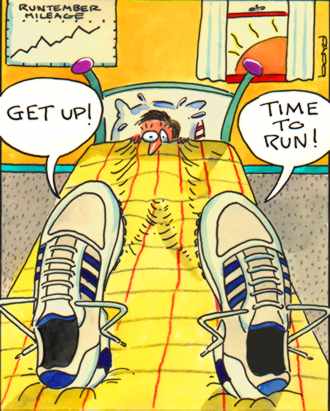· 10 x 400 with double rest-to-work time
This is a fantastic workout for developing the ability to maintain technique and speed at just above lactic threshold. You want to do this workout based on "best-average" time. This means that you should be completing the 400s in the fastest time that you can maintain for all 10 of them. The time of your rest should be about double the time of your work. At the minimum, your rest should be 2 minutes, but should not really be more than 4 minutes. The last few repeats should be very difficult and will hurt as lactic acid is accumulating in your body.
Workout number two:
· 1 x 1 mile with 1:00 minute rest
· 2 x 800 with 1:30 rest between each
· 3 x 400 with 1:30 rest between each
· 4 x 200 with 2:00 rest between each
· 5 x 100 with 2:00 rest between each
With this workout you want to be increasing your speed throughout. You will start at your 10km race pace for the first mile, dropping to 5km pace for the 800s. The 400s will be done at your mile pace and the 200s will be done at 1km pace. The 100s are to be done all out. As the speed increases, so will your rest increase in relation to the work being done. While you only get 30 seconds more rest between the 400s and 100s, you are also doing one-quarter the work. Focus on perfect technique as the repeat distance gets shorter.
Workout number three:
- 4 x 200 with 45 seconds rest
- 2 x 400 with 1:00 rest
- 1 x 800 with 2:00 rest
- 2 x 400 with 1:00 rest
- 4 x 200 with 45 seconds rest
A classic pyramid. In this workout the focus will be on the 800.Unlike the previous workout, where you increase the speed throughout the entire workout, the speed will peak at the 800. You want to perform the 800 at your mile race pace, meaning that the 400 will be at your 5K race pace and your 200 will be at 10km race pace, on both sides of the pyramid. The second time through the 400s and 200s, you will feel as though you are going slower than the first time through them, but in fact you will be right on pace. Slowing down after the tough 800 will feel like relief.
Workout number four:
· 3 x 400 with 30 seconds rest
· 3 x 1 mile with 1:30 rest
· 3 x 400 with 30 seconds rest
This workout is to mimic road-race conditions. Often in races you will see people sprinting off the start. Whether it is by design or just a burst of adrenaline, the majority of people take it out fast off the gun. After a few kilometers they settle into a more sustainable rhythm, only to build into another sprint to finish the race off. Thus it is important for you to work the set of 400s hard. You should perform the 400s at a pace that is faster than your 5km race pace. The goal is to fatigue yourself so that when you hit the middle part of the workout you will be mimicking race day. The workout does not work if you sandbag the first set of 400s so that you can run super-fast during the mile repeats.
Now, the crux of the workout lies in the mile repeats. The 400s are just really to set your body up for running with lactate during the mile repeats. During this portion of the workout you will want to be running at your 10K pace, focusing on technique and rhythm. The rest for the mile repeats is a bit longer than it was/will be for the 400s. Upon completion of the miles, it is back to speed. The second set of 400s is to toughen you up for the end of races. This is where "guts" are built. You will want to run this set of 400s as fast as or faster than your first set. No excuses. Run your butt off!
Workout number five:
· Continuous 400s as 200 hard/200 easy
This workout is a continuous run. After a good warm up you will begin running 400s. The pace for each lap should be based on a slow 1km pace for you. That means that if you can run 3:30 in a race, then you should be looking at about 5:00min/km for this workout, which would then translate to 2:00min/400m. This means that you will complete each lap in 2:00 minutes, but half of it is an all-out sprint, and the other half is a very, very easy jog. This will continue for a time determined by the individual or coach. A suggested time would be between 20-30 minutes, but (especially the first time that this workout is attempted) listen to your body.
from Runner's Web by Lance Watson
http://www.runnersweb.com/running/news/rw_news_20050309_LW_Track.html


No comments:
Post a Comment